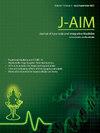苦参镇痛、抗炎、抗关节炎分子机制的网络药理学及计算机模拟研究Dunal植物成份
IF 1.9
Q3 INTEGRATIVE & COMPLEMENTARY MEDICINE
引用次数: 0
摘要
背景:withania somnifera (L.)杜纳尔,通常被称为ashwagandha,是一种印度草药,属于茄科。目的探讨苦参(Withania somnifera, L.)植物成分的镇痛、抗炎和抗关节炎作用。Dunal (W. somnifera)的网络药理学与计算机对接研究。方法选取5种主要植物成分,分别为ashwagandhanolide、槲皮素、witherin A、withanone和withanolide A,进行网络药理研究。利用分子对接(MD)和模拟工具进一步评估了这五种植物成分的结合特性。对具有显著结合亲和力的化合物进行了进一步的药代动力学和毒性(ADMET)预测。结果网络药理学研究表明,在5个选定的成分中,金针叶苷A、金针叶内酯A和槲皮素可与多种炎症和疼痛相关基因相互作用。在计算机研究中,所有五种成分都被发现与炎症和伤害蛋白环氧化酶、脂氧化酶、髓过氧化物酶和组织蛋白酶b有显著的相互作用。此外,ADMET研究预测所有五种植物成分都不能穿过血脑屏障,但具有高的胃肠道吸收和生物利用度。槲皮素预测具有致突变性,其他三种成分(withaferin A、withanone和withanolide A)预测具有免疫毒性。MD模拟研究表明,脂肪氧合酶e_ashwagandhanolide和组织蛋白酶B_ashwagandhanolide复合物具有较低的RMSD、RMSF和较高的h键,表明ashwagandhanolide与脂肪氧合酶和组织蛋白酶b具有较高的稳定性。结论ashwagandhanolide、槲皮素、withaferin A、withanone和withanolide A可能具有镇痛、抗炎和抗关节炎的活性。这些研究结果为今后在体外和体内进一步研究这些成分的治疗作用奠定了基础。本文章由计算机程序翻译,如有差异,请以英文原文为准。
Network pharmacology and in-silico studies for molecular mechanisms of analgesic, anti-inflammatory and anti-arthritic effects of Withania somnifera (L.) Dunal phytoconstituents
Background
Withania somnifera (L.) Dunal, commonly known as ashwagandha, is an Ayurvedic herb belonging to the family Solanaceae.
Objectives
This study aims to explore the analgesic, anti-inflammatory and anti-arthritic potential of phytoconstituents of Withania somnifera (L.) Dunal (W. somnifera) by network pharmacology and in-silico docking studies.
Methods
Five major phytoconstituents, namely ashwagandhanolide, quercetin, withaferin A, withanone and withanolide A, were selected for the network pharmacology study. All five phytoconstituents were further evaluated for their binding properties using molecular docking (MD) and simulation tools. The compounds that exhibited significant binding affinities were further studied for pharmacokinetic and toxicity (ADMET) predictions.
Results
The network pharmacology study showed that out of the five selected constituents, withaferin A, withanolide A and quercetin can interact with various inflammation and pain-related genes. In in-silico studies, all five constituents were found to have significant interactions with inflammatory and nociception proteins cyclooxygenases, lipoxygenase, myeloperoxidase and cathepsin B. Further, ADMET studies predicted that all five phytoconstituents could not cross the blood-brain barrier but have high gastrointestinal absorption and bioavailability. Quercetin was predicted to have mutagenic potential and the other three constituents (withaferin A, withanone and withanolide A) were predicted to have immunotoxicity. The MD simulation studies showed that the complexes lipoxygenase_ashwagandhanolide and cathepsin B_ashwagandhanolide exhibit lower RMSD, RMSF, and higher H-bonding, indicating greater stability of ashwagandhanolide with lipoxygenase and cathepsin B.
Conclusion
Ashwagandhanolide, quercetin, withaferin A, withanone, and withanolide A from W. somnifera may show the potential for analgesic, anti-inflammatory, and anti-arthritic activities. These findings provide a foundation for future in-vitro and in-vivo studies to confirm the therapeutic efficacy of these phytoconstituents from W. somnifera.
求助全文
通过发布文献求助,成功后即可免费获取论文全文。
去求助
来源期刊

Journal of Ayurveda and Integrative Medicine
INTEGRATIVE & COMPLEMENTARY MEDICINE-
CiteScore
4.70
自引率
12.50%
发文量
136
审稿时长
30 weeks
 求助内容:
求助内容: 应助结果提醒方式:
应助结果提醒方式:


